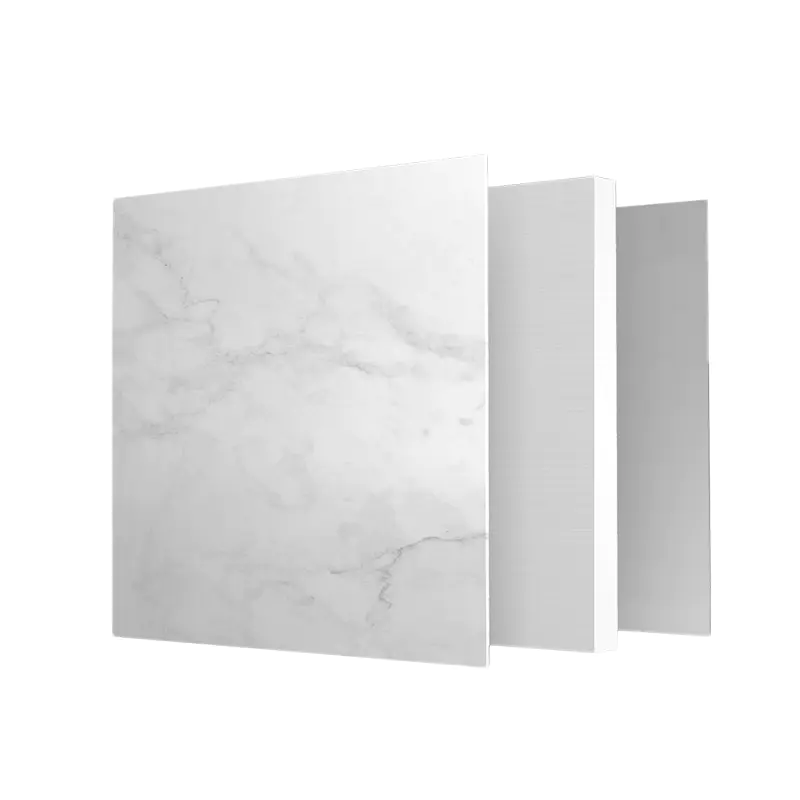An aluminum composite panel (ACP), often referred to as an aluminum composite material (ACM), is a flat panel consisting of two thin coil-coated aluminum sheets bonded to a non-aluminum core. This core is typically made of polyethylene (PE) or a mineral-filled fire-retardant material. The result is a lightweight yet rigid panel with excellent flatness and a wide range of surface finishes, making it a highly versatile material in modern architecture and various other industries.
The unique properties of ACPs stem from their layered structure:
Protective Film: A removable plastic film protects the panel's surface during transportation and installation.
PVDF/PE Coating: This is the visible outer layer, typically a polyester (PE) coating for interior applications or a high-performance polyvinylidene fluoride (PVDF) coating for exterior use. PVDF offers superior resistance to weathering, UV radiation, and chemical corrosion, ensuring color stability and longevity. Other coatings like FEVE (Fluoroethylene Vinyl Ether) are also used for their enhanced durability and gloss retention.
Aluminum Skin: Two thin sheets of aluminum, usually alloy 3003 or 5005, provide the structural integrity and rigidity. The thickness of these sheets can vary, impacting the panel's strength and overall cost.
Adhesive Layer: A special adhesive film bonds the aluminum skins to the core material, ensuring a strong and durable laminate.
Core Material:
Polyethylene (PE) Core: This is the most common and cost-effective core, offering good insulation and sound dampening properties. However, it is combustible, limiting its use in certain building applications, especially high-rise structures.
Fire-Retardant (FR) Core: These cores incorporate mineral fillers, significantly improving the panel's fire resistance. They are often classified as A2 (non-combustible) or B1 (limited combustibility) according to various international building codes.
Other Cores: Some manufacturers also offer honeycomb, corrugated, or even recycled content cores for specific performance requirements like enhanced rigidity or sustainability.
Mill Finish Aluminum (Backside): The reverse side of the panel typically has a mill finish or a service coating to protect the aluminum.
ACPs are typically manufactured through a continuous lamination process. This involves unrolling the pre-coated aluminum coils, applying the adhesive, extruding the core material, and then continuously bonding these layers together under heat and pressure. The resulting continuous sheet is then cut to specific panel dimensions.
ACPs offer a compelling combination of properties that contribute to their widespread adoption:
Lightweight: Significantly lighter than solid aluminum panels or other traditional cladding materials, reducing the structural load on buildings and simplifying installation.
High Rigidity and Flatness: Despite being lightweight, the composite structure provides excellent rigidity and an exceptionally flat surface, minimizing oil-canning or rippling effects.
Excellent Formability: ACPs can be easily cut, routed, grooved, bent, and folded using conventional tools, allowing for complex architectural designs and custom shapes.
Durability and Weather Resistance: PVDF-coated ACPs offer superior resistance to UV radiation, extreme temperatures, pollution, and corrosion, ensuring long-term aesthetic appeal and performance.
Sound and Thermal Insulation: The core material contributes to improved thermal insulation, reducing energy consumption for heating and cooling, and also offers good sound dampening properties.
Wide Range of Finishes and Colors: Available in a vast array of colors, metallic finishes, stone/wood patterns, and even custom designs, offering immense design flexibility.
Easy Maintenance: The smooth, non-porous surface is easy to clean and maintain.
Cost-Effectiveness: When considering the entire lifecycle, including installation and maintenance, ACPs often prove to be a more cost-effective solution compared to many traditional cladding materials.
The versatility of ACPs makes them suitable for a diverse range of applications:
Building Facades (Cladding): This is the most prominent application, used for both new constructions and renovations due to their aesthetic appeal, durability, and ease of installation.
Interior Decoration: Wall linings, ceilings, partitions, column covers, and signage.
Signage and Advertising: Lightweight and easy to print on, ideal for billboards, display stands, and retail signage.
Canopies and Awnings: Providing durable and aesthetically pleasing overhead protection.
Retail Storefronts and Corporate Identity: Creating modern and attractive building exteriors.
Transportation: Used in the interior and exterior of trains, buses, and marine vessels.
Industrial Applications: Machine covers, cleanroom walls, and specialized enclosures.
While ACPs offer numerous advantages, several factors need to be considered:
Fire Safety: The fire performance of ACPs is a critical concern, especially after several high-profile building fires involving PE-core panels. This has led to stricter building codes and a strong preference for FR and A2 core panels in many regions.
Installation Expertise: Proper installation is crucial for maximizing the performance and longevity of ACPs. This includes appropriate fastening systems, sealing, and ventilation.
Sustainability: Manufacturers are increasingly focusing on developing more sustainable ACPs, including those with recycled content, improved recyclability, and more environmentally friendly production processes.
Advanced Coatings: Ongoing research is exploring new coating technologies offering enhanced self-cleaning properties, anti-bacterial surfaces, and greater resistance to scratches and graffiti.
In conclusion, aluminum composite panels have revolutionized modern construction and design with their unique blend of aesthetics, performance, and versatility. As technology advances and sustainability concerns grow, the development of safer and more environmentally friendly ACPs will continue to shape their role in the built environment.
